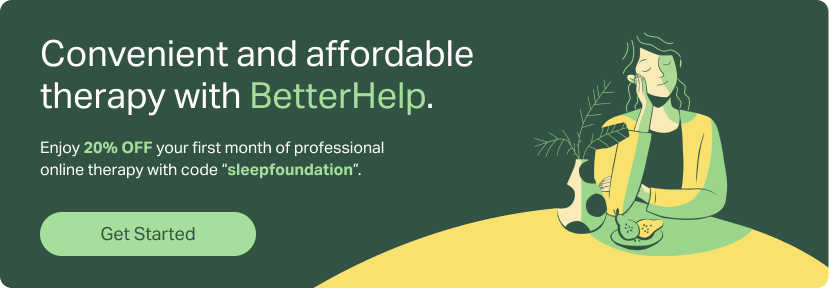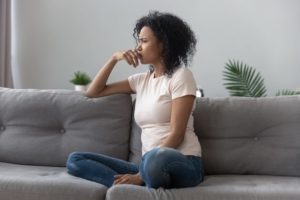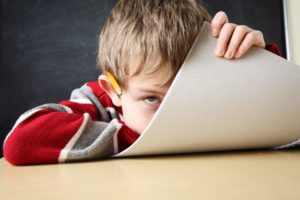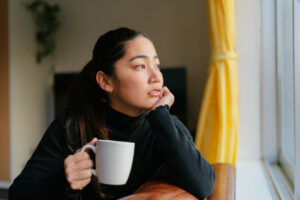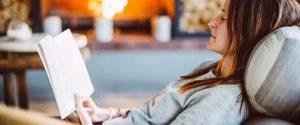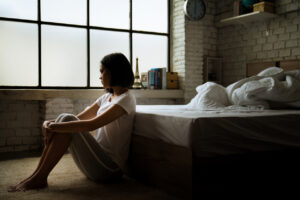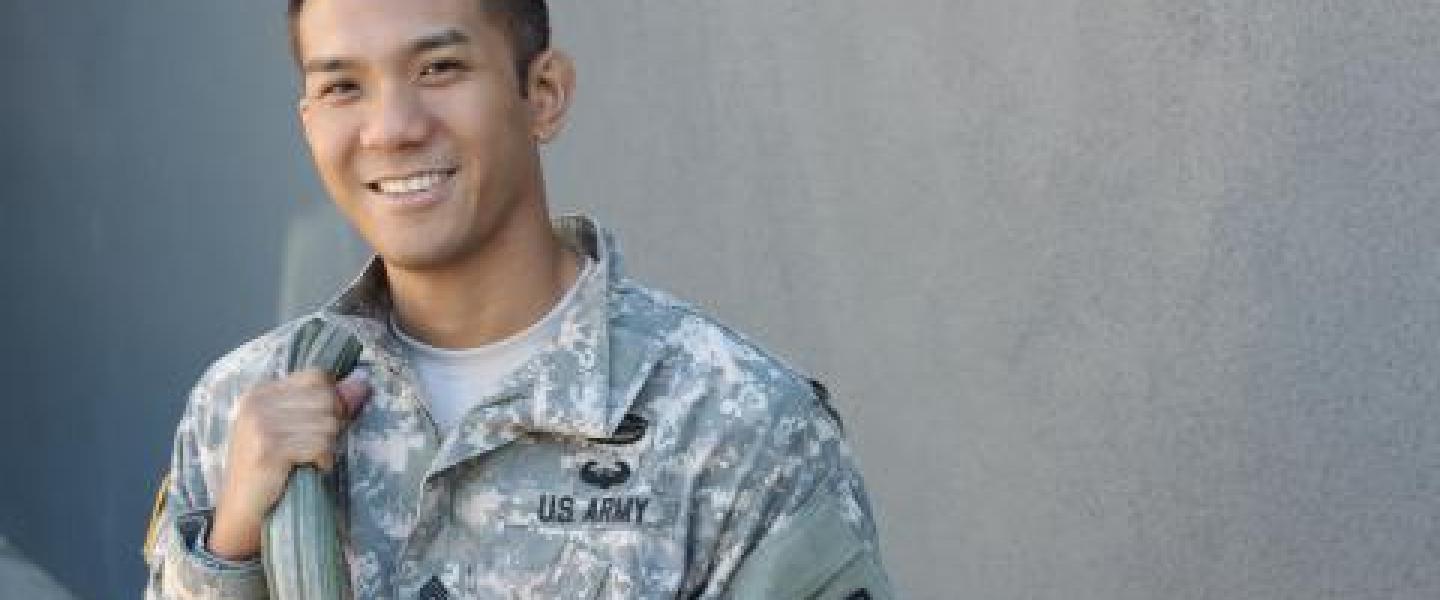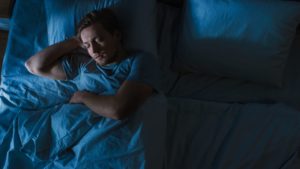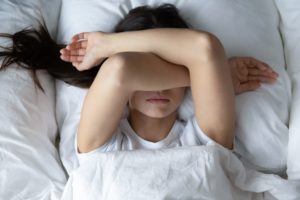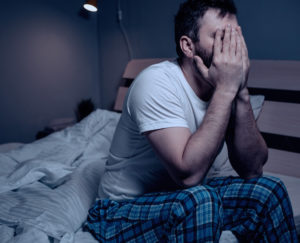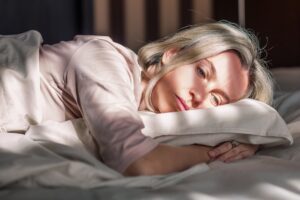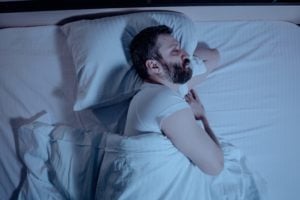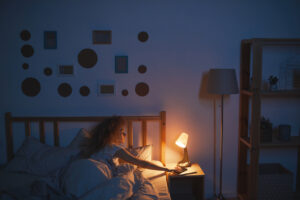When you buy through our links, we may earn a commission. Products or services may be offered by an affiliated entity. Learn more.
Somniphobia: Understanding the Fear of Sleep
Some people experience a deep and powerful fear of objects or situations that others see as relatively harmless, such as clowns, spiders, or heights. These intense fears about seemingly neutral objects are called specific phobias, and they occur in about 12% of adults at some point.
Certain phobias may have a significant impact on everyday life. Someone with somniphobia, also known as hypnophobia, can experience extreme anxiety and fear around falling asleep that can potentially lead to lasting consequences.
What Is Somniphobia?
Somniphobia is the fear of falling asleep . While many people can avoid their phobias, sleep is essential to good health and wellbeing. Chronic sleep loss has been shown to increase health-related risks like obesity, diabetes, and heart disease . Experiencing extreme fear or anxiety around sleep can have a direct impact on your overall health.
Symptoms of Somniphobia
Many phobias share similar symptoms. Common symptoms that arise when a person is afraid of falling asleep may include:
- Profuse sweating
- Rapid heartbeat
- Shortness of breath
- Panic or fear when thinking about sleep or attempting to sleep (some people may have this reaction around things that represent sleep, like mattresses in a store)
- Trembling
- The desire to avoid sleeping at all costs
These symptoms are also very similar to the symptoms of a panic disorder . The key difference between panic disorders and phobias is that panic disorders are not as tightly linked to a specific object or situation. Phobia symptoms, like somniphobia, are only experienced when the feared situation is happening or close to happening.
Causes of Somniphobia
The causes of phobias, including somniphobia, are unclear. Phobias in general are thought to arise from a combination of genetic and environmental factors . Usually phobias develop in childhood. They may be more likely to occur if a close family member also has phobias, whether because of inherited traits or because of shared life experiences . Phobias are more common in females and they can also exist alongside other anxiety disorders.
Bedtime anxiety or fear of falling asleep is a common symptom of nightmare disorder and post-traumatic stress disorder (PTSD), both of which usually arise in connection with traumatic experiences. People with these conditions may develop a fear of falling asleep because they wish to avoid traumatic nightmares or because they feel vulnerable during sleep.
One study found that people with PTSD who experienced a fear of sleep were more likely to have nightmares. Sleep avoidance and the resulting sleep deprivation may also increase the likelihood of developing insomnia, a sleep disorder in which you struggle to fall and stay asleep.
Another sleep disorder associated with somniphobia is recurrent isolated sleep paralysis, in which the individual is momentarily unable to move when falling asleep or waking up and has associated hallucinations. Understandably, these experiences can be stressful and lead to nervousness around falling asleep. This disorder tends to run in families. It may be necessary to complete a sleep study to rule out these potential contributions.
Diagnosing Somniphobia
The Diagnostic and Statistical Manual (DSM) used by mental health professionals to diagnose mental or behavioral health issues lists seven main criteria for specific phobias :
- Significant fear or anxiety related to an object or situation
- Fear or anxiety almost always occur when presented with the situation or object
- People actively avoid the given object or situation, and experience anxiety or fear when unable to avoid it
- The phobia causes distress or impairs functioning in other areas of life, like at work or school
- The fear and anxiety around the specific phobia are lasting, usually enduring for more than 6 months
- The fear or anxiety are considered excessive compared to the real threat posed by the object or situation, and bearing in mind cultural expectations
- Symptoms are not more reliably explained by the presence of another mental disorder, such as obsessive-compulsive disorder (OCD) or social anxiety disorder
Treatments for Somniphobia
Treatments for somniphobia include a mix of behavioral health treatments and medication.
Exposure Therapy
Exposure therapy is the process of intentionally exposing yourself to a fearful object or situation, and gradually increasing the level of exposure as you learn to regulate your anxiety. Exposure therapy is the most common treatment for specific phobias. It can be carried out either in real life or using techniques such as visualization or virtual reality.
If you have somniphobia, the targeted phobia is falling asleep. You’ll work with a mental health professional to identify experiences that cause you comparatively little distress but which are still related to sleeping. For example, this might be changing into your pajama pants when you get home.
Your treatment provider will help you identify physical anxiety symptoms, such as rapid heartbeat or shortness of breath, and track when these symptoms subside. They will also teach you coping skills and relaxation techniques, such as deep breathing. Over time, you move up the ladder from the least fearful experience to the most fearful experience, eventually aiming to conquer the fear of falling asleep. Exposure therapy is successful for treating specific phobias in more than 90% of people who try it.
Cognitive Behavioral Therapy
Cognitive behavioral therapy (CBT) is a therapeutic treatment approach that focuses on changing the relationship between your thoughts (cognitions), feelings and behaviors. CBT has been used for treating anxiety disorders for many years and there is ample research that shows CBT is effective in helping people reduce anxiety, fear and panic . Although it is not a first-line treatment for specific phobias, CBT may be a safe and effective treatment option for adults or children struggling with somniphobia.
In CBT, you work to break unhelpful thoughts around sleeping and implement new and more helpful thoughts and behaviors. For example, if you fear sleep because you believe being asleep is unsafe, your mental health professional helps you address this thought through cognitive restructuring techniques (identifying unhelpful thoughts and building helpful ones) and behavioral interventions. These techniques may overlap with exposure therapy.
Medication
There is no medication that is specifically formulated or used for somniphobia. However, medications that help reduce anxiety or fear may be helpful in reducing overall somniphobia symptoms. These medications should only be taken under your doctor’s supervision:
- D-cycloserine: D-cycloserine is an N-methyl D-aspartate (NMDA) receptor agonist that has been studied for its ability to limit the fear response during exposure therapy. More research is needed to see if D-cycloserine is really effective in treating specific phobias.
- Cortisol and Oxytocin: Like D-cycloserine, studies have found that taking cortisol (an oral steroid) before exposure therapy for a fear of heights or spiders improved treatment outcomes.
- Benzodiazepines: A class of drugs that is used primarily to treat anxiety and panic disorders, benzodiazepines may also help with somniphobia symptoms. Benzodiazepines can be habit-forming and are therefore highly regulated and controlled. They are generally recommended for short-term use only.
- Beta Blockers: Beta blockers are used to lower blood pressure. When exposure therapy has not worked and a person is unable to avoid the feared object or situation, taking beta blockers a few hours beforehand may help reduce anxiety.
Sleep aids may help you get a better night’s rest, but they may not be helpful in the long run. On the other hand, healthy lifestyle habits such as getting regular exercise and reducing caffeine consumption may help you manage your symptoms.
When to Talk to Your Doctor
If you notice that you are spending more and more time avoiding sleep, or if you experience extreme panic or anxiety when thinking about falling asleep, talk to your doctor. Ask for a referral to a mental health provider and set up an appointment to see them if your symptoms do not resolve with lifestyle changes or medical intervention.

Still have questions? Ask our community!
Join our Sleep Care Community — a trusted hub of sleep health professionals, product specialists, and people just like you. Whether you need expert sleep advice for your insomnia or you’re searching for the perfect mattress, we’ve got you covered. Get personalized guidance from the experts who know sleep best.
References
15 Sources
-
Kazaglis, L., & Bornemann, M. A. C. (2016). Classification of parasomnias. Current Sleep Medicine Reports, 2(2), 45-52.
https://link.springer.com/article/10.1007%2Fs40675-016-0039-y -
National Heart, Lung, and Blood Institute. (n.d.). Sleep deprivation and deficiency.
https://www.nhlbi.nih.gov/health-topics/sleep-deprivation-and-deficiency -
Barnhill, J.W. (2020, April). Specific phobic disorders. Merck Manual Professional Version.
https://www.merckmanuals.com/professional/psychiatric-disorders/anxiety-and-stressor-related-disorders/specific-phobic-disorders -
MedlinePlus: National Library of Medicine (US). (2016, August 9). Phobias.
https://medlineplus.gov/phobias.html -
MedlinePlus: National Library of Medicine (US). (2021, August 10). Panic disorder., Retrieved December 6, 2021, from
https://medlineplus.gov/panicdisorder.html -
Sawyers, C., Ollendick, T., Brotman, M. A., Pine, D. S., Leibenluft, E., Carney, D. M., Roberson-Nay, R., & Hettema, J. M. (2019). The genetic and environmental structure of fear and anxiety in juvenile twins. American Journal of Medical Genetics. Part B, Neuropsychiatric Genetics: The Official Publication of the International Society of Psychiatric Genetics, 180(3), 204–212.
https://pubmed.ncbi.nlm.nih.gov/30708402/ -
Goodwin G. M. (2015). The overlap between anxiety, depression, and obsessive-compulsive disorder. Dialogues in Clinical Neuroscience, 17(3), 249–260.
https://pubmed.ncbi.nlm.nih.gov/26487806/ -
American Academy of Sleep Medicine. (2014). The International Classification of Sleep Disorders – Third Edition (ICSD-3). Darien, IL.
https://aasm.org/ -
Kanady, J. C., Talbot, L. S., Maguen, S., Straus, L. D., Richards, A., Ruoff, L., Metzler, T. J., & Neylan, T. C. (2018). Cognitive behavioral therapy for insomnia reduces fear of sleep in individuals with posttraumatic stress disorder. Journal of Clinical Sleep Medicine: JCSM: Official Publication of the American Academy of Sleep Medicine, 14(7), 1193–1203.
https://pubmed.ncbi.nlm.nih.gov/29991428/ -
Short, N. A., Allan, N. P., Stentz, L., Portero, A. K., & Schmidt, N. B. (2018). Predictors of insomnia symptoms and nightmares among individuals with post-traumatic stress disorder: An ecological momentary assessment study. Journal of Sleep Research, 27(1), 64–72.
https://pubmed.ncbi.nlm.nih.gov/28771875/ -
Substance Abuse and Mental Health Services Administration. (2016). Impact of the DSM-IV to DSM-5 changes on the National Survey on Drug Use and Health. Substance Abuse and Mental Health Services Administration (US).
https://pubmed.ncbi.nlm.nih.gov/30199183/ -
Eaton, W. W., Bienvenu, O. J., & Miloyan, B. (2018). Specific phobias. The Lancet. Psychiatry, 5(8), 678–686.
https://pubmed.ncbi.nlm.nih.gov/30060873/ -
Bandelow, B., Reitt, M., Röver, C., Michaelis, S., Görlich, Y., & Wedekind, D. (2015). Efficacy of treatments for anxiety disorders: A meta-analysis. International Clinical Psychopharmacology, 30(4), 183–192.
https://pubmed.ncbi.nlm.nih.gov/25932596/ -
Wang, Z., Whiteside, S., Sim, L., Farah, W., Morrow, A. S., Alsawas, M., Barrionuevo, P., Tello, M., Asi, N., Beuschel, B., Daraz, L., Almasri, J., Zaiem, F., Larrea-Mantilla, L., Ponce, O. J., LeBlanc, A., Prokop, L. J., & Murad, M. H. (2017). Comparative effectiveness and safety of cognitive behavioral therapy and pharmacotherapy for childhood anxiety disorders: A systematic review and meta-analysis. JAMA Pediatrics, 171(11), 1049–1056.
https://pubmed.ncbi.nlm.nih.gov/28859190/ -
Garakani, A., Murrough, J. W., Freire, R. C., Thom, R. P., Larkin, K., Buono, F. D., & Iosifescu, D. V. (2020). Pharmacotherapy of anxiety disorders: Current and emerging treatment options. Frontiers in Psychiatry, 11, Article 595584.
https://pubmed.ncbi.nlm.nih.gov/33424664/


